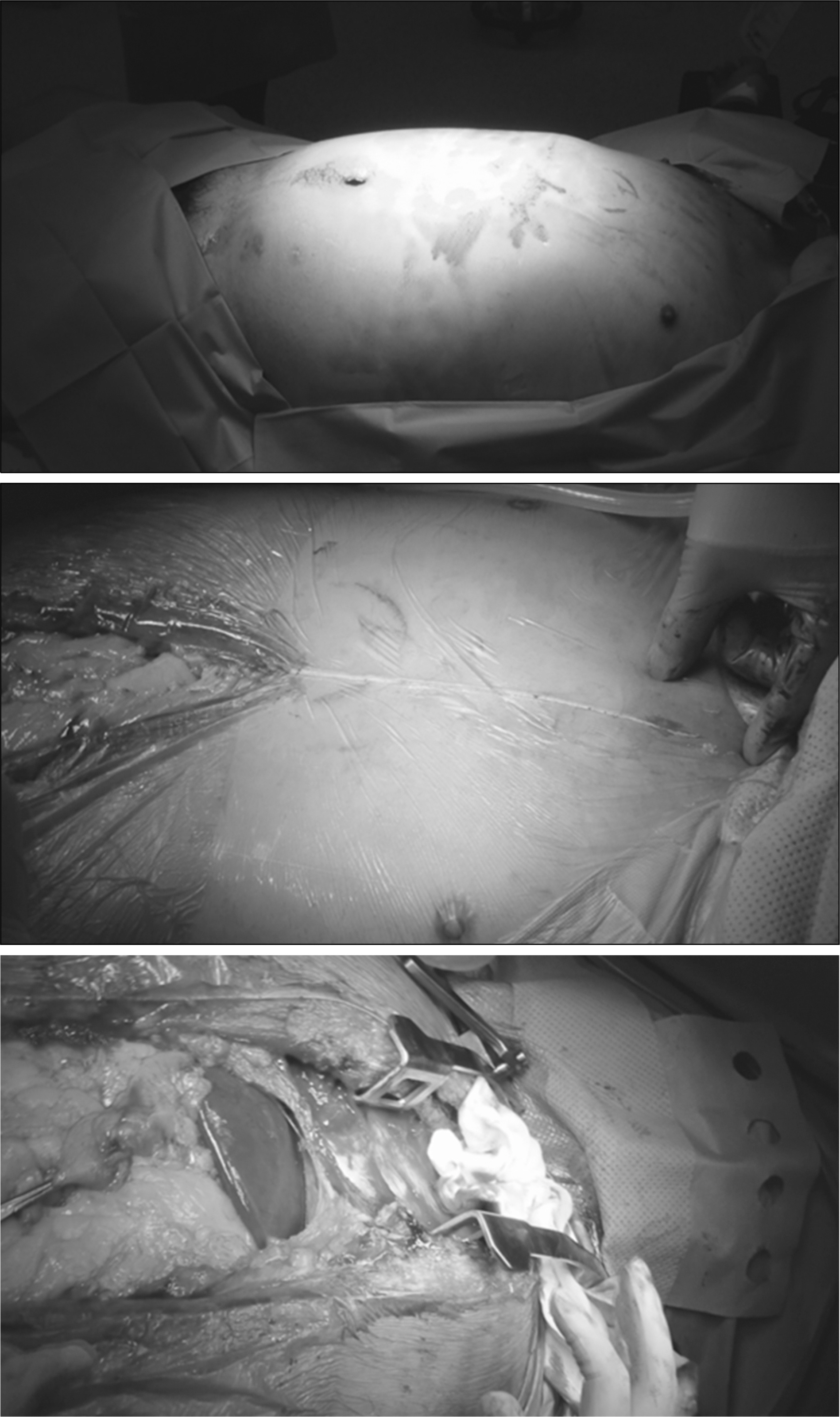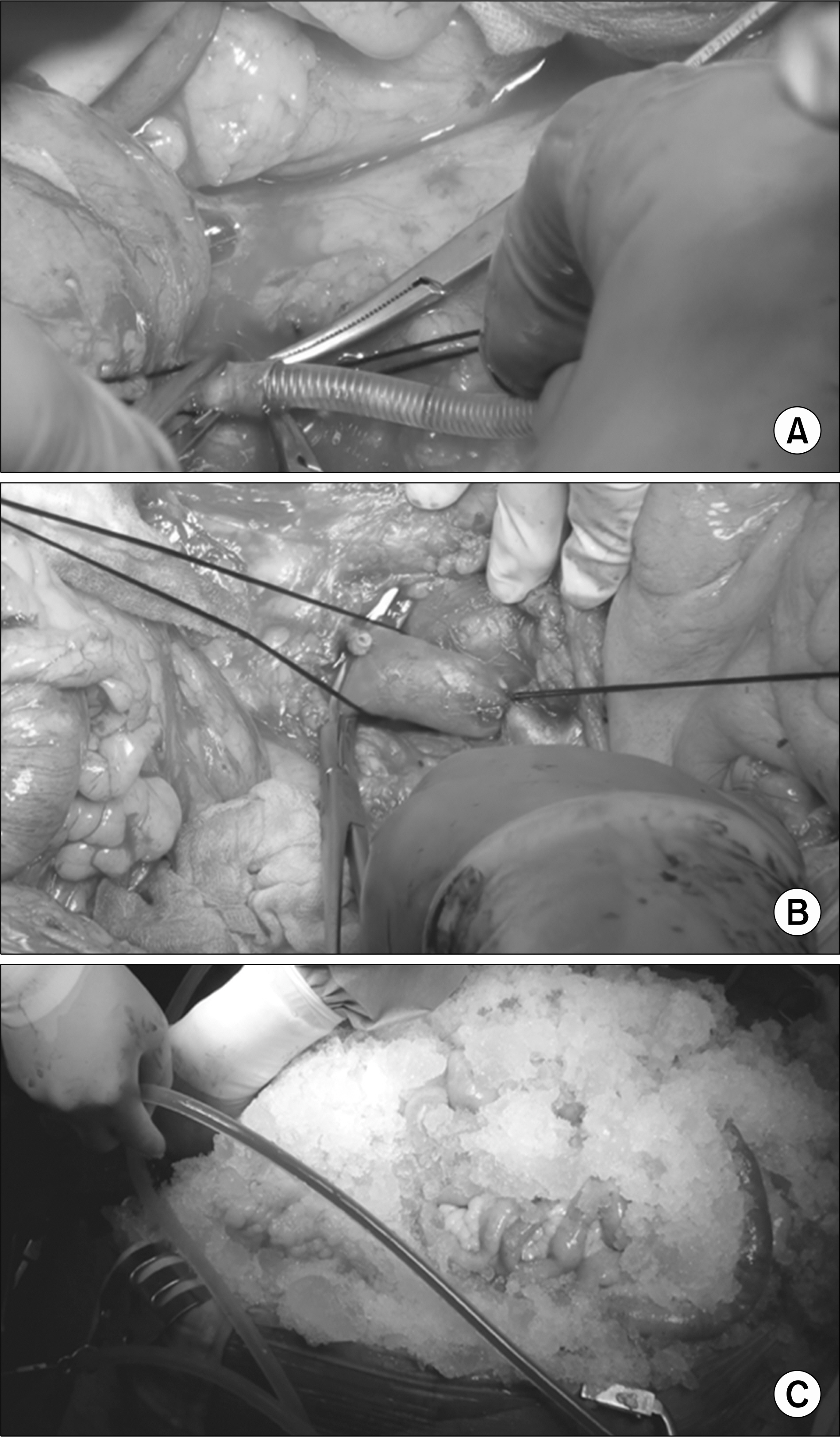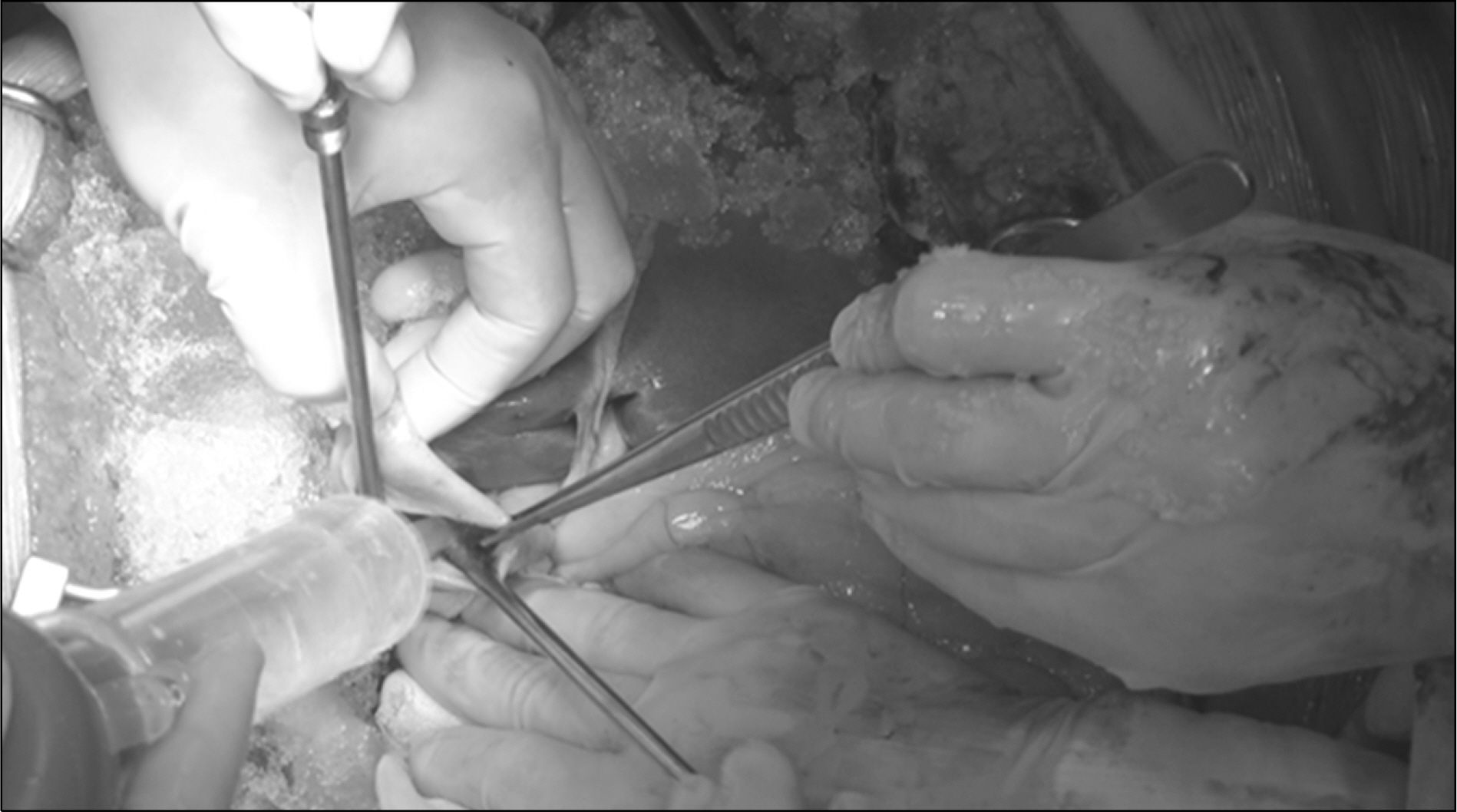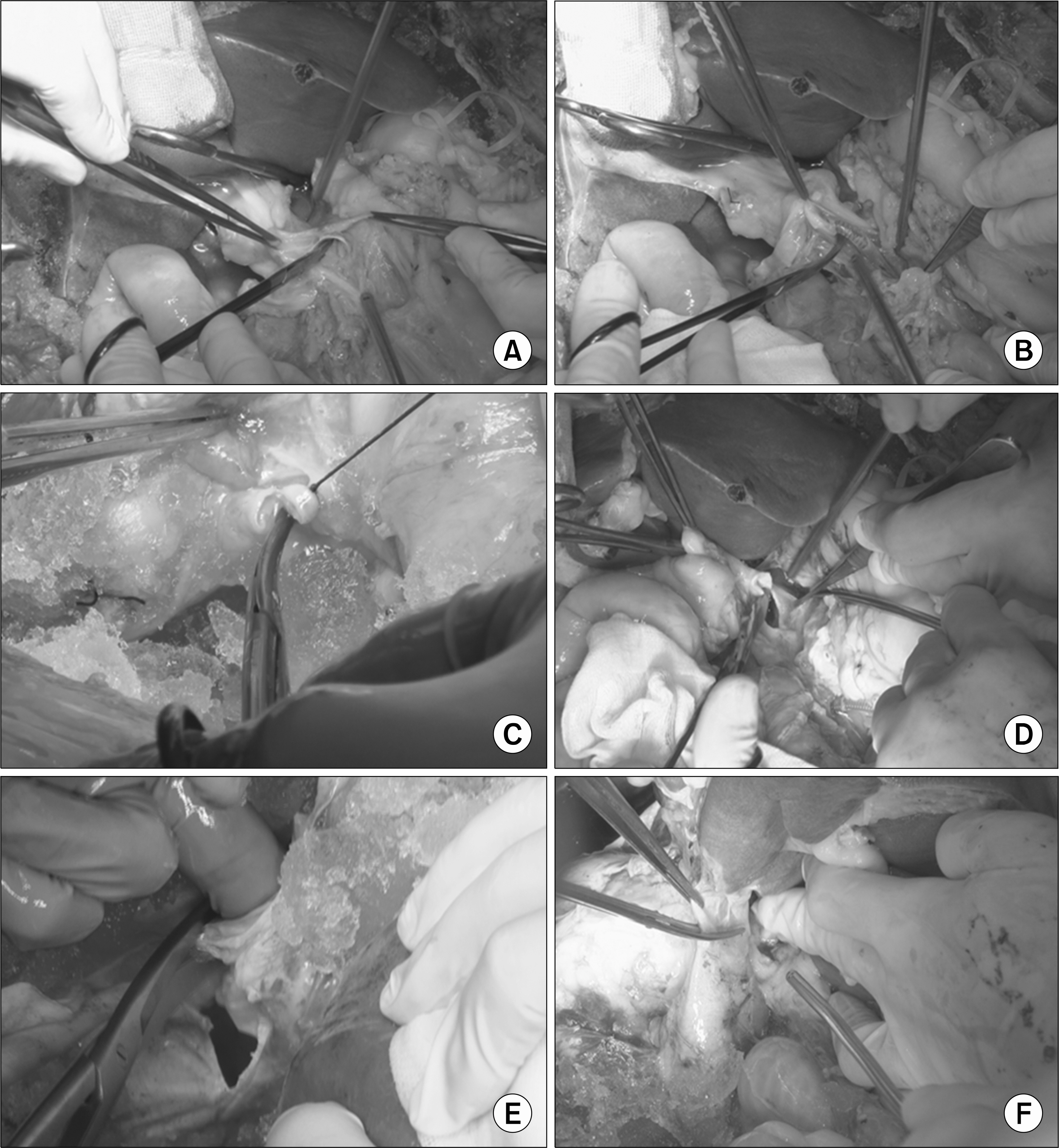J Korean Soc Transplant.
2015 Sep;29(3):109-117. 10.4285/jkstn.2015.29.3.109.
Liver Procurement
- Affiliations
-
- 1Department of Surgery, Seoul National University Bundang Hospital, Seongnam, Korea.
- 2Department of Surgery, Seoul National University Hospital, Seoul, Korea. kwleegs@gmail.com
- 3Department of Surgery, Seoul National University College of Medicine, Seoul, Korea.
- KMID: 2202583
- DOI: http://doi.org/10.4285/jkstn.2015.29.3.109
Abstract
- With increasing demand for liver transplantation, liver grafts are used from marginal donors who were not considered suitable. This trend toward the use of marginal donors reinforces the need to balance the recipient's condition and graft quality and to perform a liver retrieval process with a proper method for preservation of liver function. Although the issues in organ procurement are debatable, rapid and high pressure perfusion for the aorta only with a cold dissection method can be an optimal method for the successful recipient outcome in liver transplantation using a marginal graft.
MeSH Terms
Figure
Cited by 1 articles
-
Organ procurement in a deceased donor
Hong Pil Hwang, Jong Man Kim, Sung Shin, Hyung Joon Ahn, Sik Lee, Dong Jin Joo, Seung Yeup Han, Seok Jin Haam, Jeong Kye Hwang, Hee Chul Yu
Korean J Transplant. 2020;34(3):134-150. doi: 10.4285/kjt.2020.34.3.134.
Reference
-
References
1). Ministry of Health & Welfare, Korean Network for Organ Shering. 2014 Konos Annual Report. Seoul: KONOS; 2015. (보건복지부 질병관리본부 장기이식관리센터. 장기이식 통계연보, 2014. 서울: 질병관리본부 장기이식관리센터: 질병관리본부 장기이식관리센터;2015. .).2). Yu HC, Cho BH. How to Do I Make an Organ Procurement in Deceased Donor? J Korean Soc Transplant. 2006; 20:14–24. (유희철, 조백환. 뇌사자에서의 장기구득 방법. 대한이식학회지 2006;20: 14–24.).3). Chapman WC, Vachharajani N, Collins KM, Garonzik-Wang J, Park Y, Wellen JR, et al. Donor age-based analysis of liver transplantation outcomes: short- and longterm outcomes are similar regardless of donor age. J Am Coll Surg. 2015; 221:59–69.
Article4). Darius T, Monbaliu D, Jochmans I, Meurisse N, Desschans B, Coosemans W, et al. Septuagenarian and octogenarian donors provide excellent liver grafts for transplantation. Transplant Proc. 2012; 44:2861–7.
Article5). Goldaracena N, Quiñ onez E, Mé ndez P, Anders M, Orozco Ganem F, Mastai R, et al. Extremely marginal liver grafts from deceased donors have outcome similar to ideal grafts. Transplant Proc. 2012; 44:2219–22.
Article6). Starzl TE, Hakala TR, Shaw BW Jr, Hardesty RL, Rosenthal TJ, Griffith BP, et al. A flexible procedure for multiple cadaveric organ procurement. Surg Gynecol Obstet. 1984; 158:223–30.
Article7). Margreiter R, Kö nigsrainer A, Schmid T, Takahashi N, Pernthaler H, Ofner D. Multiple organ procurement–a simple and safe procedure. Transplant Proc. 1991; 23:2307–8.8). Brockmann JG, Vaidya A, Reddy S, Friend PJ. Retrieval of abdominal organs for transplantation. Br J Surg. 2006; 93:133–46.
Article9). Starzl TE, Miller C, Broznick B, Makowka L. An improved technique for multiple organ harvesting. Surg Gynecol Obstet. 1987; 165:343–8.10). Klar E, Kraus T, Osswald BR, Bleyl J, Fernandes L, Mehrabi A, et al. Induction of impaired hepatic microcirculation by in situ hilus preparation in liver explantation. Zentralbl Chir. 1995; 120:482–5.11). Schemmer P, Enomoto N, Bradford BU, Bunzendahl H, Raleigh JA, Lemasters JJ, et al. Activated Kupffer cells cause a hypermetabolic state after gentle in situ manipulation of liver in rats. Am J Physiol Gastrointest Liver Physiol. 2001; 280:G1076–82.
Article12). Jung DH, Hwang S, Ahn CS, Kim KH, Moon DB, Ha TY, et al. Safety and usefulness of warm dissection technique during liver graft retrieval from deceased donors. Transplant Proc. 2015; 47:576–9.
Article13). Emond JC, Freeman RB Jr, Renz JF, Yersiz H, Rogiers X, Busuttil RW. Optimizing the use of donated cadaver livers: analysis and policy development to increase the application of split-liver transplantation. Liver Transpl. 2002; 8:863–72.
Article14). Noujaim HM, Gunson B, Mayer DA, Mirza DF, Buckels JA, Candinas D, et al. Worth continuing doing ex situ liver graft splitting? A singlecenter analysis. Am J Transplant. 2003; 3:318–23.
Article15). Hong JC, Yersiz H, Busuttil RW. Where are we today in split liver transplantation? Curr Opin Organ Transplant. 2011; 16:269–73.16). Abu-Elmagd K, Fung J, Bueno J, Martin D, Madariaga JR, Mazariegos G, et al. Logistics and technique for procurement of intestinal, pancreatic, and hepatic grafts from the same donor. Ann Surg. 2000; 232:680–7.
Article17). Nakazato PZ, Concepcion W, Bry W, Limm W, Tokunaga Y, Itasaka H, et al. Total abdominal evisceration: an en bloc technique for abdominal organ harvesting. Surgery. 1992; 111:37–47.18). Filipponi F, Oleggini M, Romagnoli P, Fossati N, Pardini P, Mosca F. Exclusively aortic cold flushing for liver procurement from hemodynamically stable donors. An experimental study in the pig. G Chir. 1996; 17:59–63.19). Gä bel M, Lidé n H, Norrby J, Friman S, Wolfbrandt A, Olausson M. Early function of liver grafts preserved with or without portal perfusion. Transplant Proc. 2001; 33:2527–8.20). de Ville de Goyet J, Hausleithner V, Malaise J, Reding R, Lerut J, Jamart J, et al. Liver procurement without in situ portal perfusion. A safe procedure for more flexible multiple organ harvesting. Transplantation. 1994; 57:1328–32.21). Iaria G, Tisone G, Pisani F, Buonomo O, Camplone C, Pollicita S, et al. High-pressure perfusion versus gravity perfusion in liver harvesting: results from a prospective randomized study. Transplant Proc. 2001; 33:957–8.
Article22). Tokunaga Y, Ozaki N, Wakashiro S, Ikai I, Kimoto M, Morimoto T, et al. Effects of perfusion pressure during flushing on the viability of the procured liver using noninvasive fluorometry. Transplantation. 1988; 45:1031–5.
Article23). Moench C, Moench K, Lohse AW, Thies J, Otto G. Prevention of ischemic-type biliary lesions by arterial back-table pressure perfusion. Liver Transpl. 2003; 9:285–9.
Article24). Blumhardt G, Lemmens P, Topalidis T, Meissler M, Baer P, Steffen R, et al. Increased flow rate of preservation solution in the hepatic artery during organ preservation can improve postischemic liver function. Transplant Proc. 1993; 25:2540–2.25). Komokata T, Nishida S, Ogata S, Hamada N, Ikoma A, Tanaka K, et al. Influence of the flow rate during flushing on porcine multivisceral preservation. In Vivo. 1998; 12:245–51.
- Full Text Links
- Actions
-
Cited
- CITED
-
- Close
- Share
- Similar articles
-
- Donor Selection, Management, and Procurement for Lung Transplantation
- National Organ Transplantation Policy
- Organ Allocation for Transplantation in the USA and Korea: The Changing Roles of Equity and Utility
- Liver abscess developed after cadaveric liver transplantation due to ligation of an accessory right hepatic artery of the donor graft
- Prerequisites and Factors for Efficient Organ Procurement Interview








